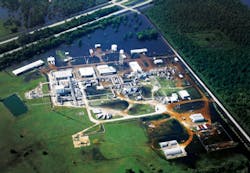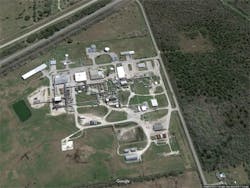About the author: Lauren Baltas is associate editor for W&WD. Baltas can be reached at [email protected] or 847.391.1019.
Floodwaters quickly submerged the Crosby plant, including many higher elevations.
Hurricane Harvey made an impact on industrial facilities across southeast Texas. Many petrochemical plants and refineries in particular were affected, some releasing hazardous substances into the air and contaminating floodwaters. According to the U.S. Coast Guard, there were nearly 100 reports of oil, chemical and sewage spills in the area. While this data is lacking, it provides a glimpse at the impact of Harvey on industrial water and wastewater and its potential environmental effects.
Shut Down
Few plants and refineries were immune to Harvey. Mark Thomas, industry manager, oil, gas, refining - U.S., for Endress+Hauser, said plant shutdowns led to roughly 1 to 2 barrels of refined product per day (bpd) lost. This is an extreme ratio, considering the U.S. produces approximately 9 bpd, according to Thomas. And, following six consecutive monthly gains, national industrial production reportedly declined 0.9%
in August 2017 due to Harvey, according to the Federal Reserve.
The primary reason for plant shutdowns was floodwaters overtaking facilities, which, in many cases, damaged costly equipment in the process. Some facilities flooded by up to 6 ft, meaning many electronics and instruments were completely submerged in water and potentially compromised. “For refineries, once they shut down, sometimes it is hard to bring them back online quickly, and it may take extra time bringing up each area,” Thomas said.
Slow Burn
Less than 30 miles outside Houston, the Arkema Inc. plant in Crosby, Texas, reportedly experienced two explosions Aug. 31. This industrial facility stores liquid organic peroxides used primarily in the production of plastic resins, polystyrene, polyethlyene, polypropylene, PVC and polyester-reinforced fiberglass, and acrylic resins. According to the New York Times, it is “one of the most hazardous” facilities in the state.
Due to the harmful nature of the chemicals stored at the Crosby plant, local officials instituted a 1.5-mile evacuation zone. Fairly rural, Crosby is home to approximately 2,300 people, with many residences in the evacuation zone perimeter.
The primary danger from the fires was airborne, not waterborne. In a corporate teleconference, Arkema President and CEO Rich Rowe emphasized that inhaling smoke from the plant can irritate the eyes, nose, lungs and upper respiratory system. Residents and officials were encouraged to avoid the smoke and seek medical attention should they inhale it. In an Aug. 31 statement, the U.S. Environmental Protection Agency, Texas Commission for Environmental Quality, Crosby Volunteer Fire Department, Harris County Office of Homeland Security and Emergency Management, and Harris County Fire Marshal’s Office said, “As with all smoke, people can limit the potential for adverse health effects by limiting their exposure. This includes staying indoors with doors and windows closed and running the air conditioning (if possible) with the fresh intake closed.”
The explosions occurred because rapidly growing floodwaters overcame primary and secondary generators, cutting off power to the site’s refrigeration. The chemicals at the Crosby plant require cold storage to prevent them from breaking down and igniting. Although crews attempted to transport the materials to higher elevations, flooding made it impossible for them to move the materials to the highest areas or transport them to offsite locations. Transportation also ran the risk of further endangering the public due to potentially overwhelming floodwater during transportation. Eventually, the organic peroxides’ increase in temperature affected their unstable nature.
The containers held approximately 500,000 lb of chemicals, and the explosion caused large smoke plumes. Arkema let the materials ignite and burn out. When not all chemical trailers burned out, Arkema safely ignited the remaining trailers. Local government and Arkema personnel monitored the site. Many of the containers burned out by Sept. 3, and by Sept. 11, Arkema confirmed that the fires were extinguished and did not cause major damage to the plant itself.
The plant's day-to-day appearance.
Industrial Adjustments
While flooding affected some facilities, lack of water affected others. For example, tanker truck cleaning facilities in Houston and Beaumont, Texas, had to suspend operations due to a water shortage. Not only did the facilities flood, but also they lacked municipal water, which prevented them from proceeding with operations once the water receded.
Much like refineries, a halt in operations for other industrial facilities means a decrease in long-term efficiency. It takes time and money to return operations to normal speed and capacity. According to Patrick Frano, technical sales consultant for Blue Sphere Water Technology and Pump Systems Inc., getting back up and running and scheduling general maintenance will be “chaotic.”
In addition, industrial wastewater discharge to the cities’ wastewater treatment plants was halted for the tanker truck cleaning facilities. According to Frano, facilities instead temporarily hauled wastewater to third-party treatment facilities. This extra step made for a significant expense. “Cleanup is well underway and will likely be going on for six to 12 months,” Thomas said.
Picking Up the Pieces
Endress+Hauser and Vector Controls offered Harvey relief in the forms industrial plants most needed. Because it has a service and calibration center in the center of the affected areas, Endress+Hauser offered resources and manpower to get the Texas plants up and running. Teams repaired flooded electronics, assessed site damage, and conducted audits for repair or replacement recommendations.
“We can provide individual technicians as well as an entire start-up team,” said Todd Lucey, general manager of U.S. operations for Endress+Hauser, in a press release Sept. 6. “Start-up teams could include project engineering managers, commissioning managers, control system programmers, instrumentation technicians, as well as valve technicians.”
Because many industrial facilities produce hazardous materials, safety—not simply economics—is a reason to return the facilities to operation. But it will not be easy.
“The support of volunteers and cleanup teams has been tremendous,” Thomas said.

